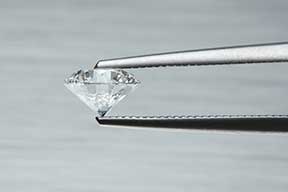Diamond Clarity

What are diamond imperfections?
Diamond clarity refers to the small imperfections – called ‘inclusions’, that are visible in gemstones either by the naked eye or through specialized equipment. Inclusions are formed in the natural diamond creation process and represent the diamond’s natural creation process. Diamonds with zero inclusions and/or very low number of inclusions are highly valuable and sought after. However, inclusions are not an end all measurement of the quality of a diamond or gemstone.
The Diamond Clarity Scale
When determining which gemstones to buy for your jewelry – it is important to remember the role each stone plays in the overall aesthetic of that individual piece. A gemstone on a necklace or bracelet that is used to accent a hero stone may have some inclusions (and that is perfectly ok) because that stone fits within the overall aesthetic of that piece.
To understand better what you can expect, here is the diamond clarity scale – as described by G.I.A.
The G.I.A. Diamond Clarity Scale
FL (Flawless) Diamonds – There are no visible inclusions or blemishes even under high magnification. Less than 1% of stones in the world are FL clarity. These stones are incredibly rare and sought after by collectors.
IF (Internally Flawless) Diamonds – There are no visible inclusions internally under high magnification. There may be some small blemishes visible on the surface of the diamond.
VVS1 & VVS2 (Very Slightly Included) Diamonds – Inclusions on these diamonds are miniscule and may be difficult to view under high magnification to the untrained eye. VVS2 have a small amount of more inclusions than the VVS1s, even at this small size.
VS1 & VS2 (Very Slightly Included) Diamonds – Minor inclusions can be seen under high magnification. VS1 clarity is higher than VS2. VS1 and VS2 diamonds are excellent accent stones as they provide excellent value in the overall jewelry process.
SI1 & SI2 (Slightly Included) Diamonds – A trained eye may be able to see small inclusions with the naked eye. Inclusions are visible under magnification. SI2 inclusions are generally visible from the pavilion portion of a gemstone (the cone-shaped lower portion of a stone) or from the top.
I1 (Included) Diamonds – Minor inclusions may be visible to the naked eye.
I2, I3 (Heavily Included) Diamonds – Obvious inclusions are visible by the naked eye.
The Factors Impacting Diamond Clarity
These are the factors that impact the clarity grading for a diamond.
Size: Larger stones are more likely to have inclusions in them. This impacts the clarity grade a stone will receive.
Number: Having less visible inclusions (whether to naked eye or magnification) impacts the clarity grading of a gemstone – particularly with VVS1/VVS2 and VS1/VS2 stones.
Position: The location of inclusions will impact the clarity grading. Inclusions located towards the bottom of a gemstone may score higher. Inclusions can become reflectors of light as well which have a bigger impact on clarity grade.
Nature: The nature of an inclusion contributes to the clarity grading it receives (See below for more information about different inclusion characteristics)
Color & Relief: How easily an inclusion is seen impacts the clarity grading. Inclusions that contrast more against the surrounding diamond receive lower scores than ones which blend more cleanly.
Types (Nature) of Inclusions
- Clouds
- Feathers
- Crystals or minerals
- Knots
- Cavities
- Cleavage
- Internal Graining
Stop by our newly renovated Yamron Jewelers Boutique to get some “clarity” on your diamond.


